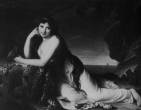
| Le site web Alexandre Dumas père | The Alexandre Dumas père Web Site | |||
 |
||||
| Dumas|Oeuvres|Gens|Galerie|Liens | Dumas|Works|People|Gallery|Links | |||

Emma, c.1761-1815, was the daughter of a blacksmith from Cheshire. Her rise in society came after her marriage to the much older Sir William Hamilton, British envoy to Naples. Despite her humble origins, and earlier relationships, Emma was a great success in Naples society, and became well-known for her performance of classical poses or `attitudes'. Nelson first met the Hamiltons in Naples in 1793 and Emma's hero-worship after his great victory at the Battle of the Nile in 1798 laid the foundation for their famous love affair. Their relationship caused a scandal both in the Mediterranean and later in London, when Nelson returned to England in the company of the Hamiltons. Nelson and Emma's daughter, Horatia was born in 1801. Her birth was kept a secret because her parents' relationship remained outside marriage, although Nelson regarded Emma as his wife in the sight of God.Dumas also wrote Les Souvenirs d'une Favorite which is a narrative of the career of Lady Emma Hamilton, and La San-Felice, a play drawn from the novel.
From Fact file Horatio Nelson 1758-1805